Advertisements
Advertisements
Question
A conducting wire ab of length l, resistance r and mass m starts sliding at t = 0 down a smooth, vertical, thick pair of connected rails as shown in figure. A uniform magnetic field B exists in the space in a direction perpendicular to the plane of the rails. (a) Write the induced emf in the loop at an instant t when the speed of the wire is v. (b) What would be the magnitude and direction of the induced current in the wire? (c) Find the downward acceleration of the wire at this instant. (d) After sufficient time, the wire starts moving with a constant velocity. Find this velocity vm. (e) Find the velocity of the wire as a function of time. (f) Find the displacement of the wire as a function of time. (g) Show that the rate of heat developed in the wire is equal to the rate at which the gravitational potential energy is decreased after steady state is reached.

Solution
(a) When the speed of the wire is v, the emf developed in the loop is, e = Blv.
(b) Magnitude of the induced current in the wire, I = \[\frac{Blv}{R}\]
As wire is moving the magnetic flux passing through the loop is increasing with time. Therefore, the direction of the current should be as such to oppose the change in magnetic flux. Therefore in order to induce the current in anticlockwise direction the current flows from b to a
(c) Due to motion of the wire in the magnetic field there is a force in upward direction (perpendicular to the wire).
The magnitude of the force on the wire carrying current i is given by F = ilB
The net force on the wire = mg - F = mg - ilB
Downward acceleration of the wire due to current, \[a= \frac{mg - F}{m}\]
\[a = \frac{mg - ilB}{m}\]
\[a = g - \frac{B^2 l^2 v}{Rm} ..........\left[ \because i = \frac{Blv}{R} \right]\]
(d) Let the wire start moving with a constant velocity.
Now,
Let the speed of the wire be vm
As speed is constant, acceleration, a = 0
\[a = g - \frac{B^2 l^2 v_m}{Rm} = 0\]
\[\frac{B^2 l^2 v_m}{Rm} = g\]
\[ \Rightarrow v_m = \frac{gRm}{B^2 l^2}\]
(e) The acceleration of the wire can be expressed as time rate of change of velocity
\[\frac{dv}{dt} = a\]
\[\therefore \frac{dv}{dt} = \left( \frac{mg - B^2 l^2 v/R}{m} \right)\]
\[ \Rightarrow \frac{dv}{\frac{mg - B^2 l^2 v/R}{m}} = dt\]
\[ \int\limits_0^v \frac{m dv}{mg - \frac{B^2 l^2 v}{R}} = \int dt^t_0 \]
\[ \Rightarrow \frac{m}{- \frac{B^2 l^2}{R}} \left[ \log\left( mg - \frac{B^2 l^2 v}{R} \right) \right]_0^v = t\]
\[ \Rightarrow \frac{- mR}{B^2 l^2}\left[ \log\left( mg - \frac{B^2 l^2 v}{R} \right) - \log(mg) \right] = t\]
\[ \Rightarrow \log\left[ \frac{mg - \frac{B^2 l^2 v}{R}}{mg} \right] = \frac{- t B^2 l^2}{mR}\]
\[ \Rightarrow \log\left[ 1 - \frac{B^2 l^2 v}{Rmg} \right] = \frac{- t B^2 l^2}{mR}\]
\[ \Rightarrow 1 - \frac{B^2 l^2 v}{Rmg} = e^{- \frac{t B^2 l^2}{mR}} \]
\[ \Rightarrow \left( 1 - e^{- \frac{t B^2 l^2}{mR}} \right) = \frac{B^2 l^2 v}{Rmg}\]
\[v = \frac{Rmg}{B^2 l^2}\left( 1 - e^{- \frac{B^2 l^2 t}{mR}} \right)\]
\[ \Rightarrow v = v_m \left( 1 - e^{- \frac{gt}{v_m}} \right) ..........\left[ \because v_m = \frac{Rmg}{B^2 l^2} \right]\]
(f) The velocity can be expressed as time rate of change of position x is the position of the wire at instant t.
\[\because\frac{dx}{dt} = v\]
Thus, the displacement of the wire can be expressed as:-
\[s = \int_0^t dx = \int_0^t vdt\]
\[\therefore s = x_t - x_0 = v_m \int\limits_0^t \left( 1 - e^{- \frac{gt}{v_m}} \right) . dt\]
\[s = v_m . \left( t + \frac{v_m}{g} . e^{- \frac{gt}{v_m}} \right)_0^t \]
\[s = \left( v_m t + \frac{{v_m}^2}{g} e^{- \frac{gt}{v_m}} \right) - \frac{{v_m}^2}{g}\]
\[s = v_m t - \frac{{v_m}^2}{g}\left( 1 - e^{- \frac{gt}{v_m}} \right)\]
(g) Rate of development of heat in the wire is given by P = V × i
\[V = Blv\]
\[i = \frac{Blv}{R}\]
Therefore, the rate of development of heat in the wire is given by
\[P = Blv \times \frac{Blv}{R} = \frac{B^2 l^2 v^2}{R}\]
\[P = \frac{B^2 l^2 {v_m}^2 \left( 1 - e^{- \frac{gt}{v_m}} \right)^2}{R} ............\left[ \because v = v_m \left( 1 - e^{- \frac{gt}{v_m}} \right) \right]\]
Rate of decrease in potential energy is given by
\[\frac{dU}{dt} = \frac{d}{dt}(mgx) = mg . \frac{dx}{dt}\]
\[\frac{dU}{dt} = mgv\]
\[\frac{dU}{dt} = mg . v_m \left( 1 - e^{- \frac{gt}{v_m}} \right) .............\left[ \because v = v_m \left( 1 - e^{- \frac{gt}{v_m}} \right) \right]\]
After the steady state, i.e., t → ∞,
\[\frac{dU}{dt} = mg v_m \]
\[P = \frac{l^2 B^2}{R} {v_m}^2 \]
\[P = \frac{l^2 B^2}{R} \times v_m \times \frac{mgR}{l^2 B^2} ............\left[ \because v_m = \frac{mgR}{l^2 B^2} \right]\]
\[P = mg v_m\]
Thus, after the steady state,
\[P = \frac{dU}{dt}\]
APPEARS IN
RELATED QUESTIONS
Two cells of emf E1 and E2 and internal resistances r1 and r2 are connected in parallel. Derive the expression for the (i) emf and (ii) internal resistance of a single equivalent cell which can replace this combination.
A circular coil of radius 10 cm, 500 turns and resistance 200 Ω is placed with its plane perpendicular to the horizontal component of the Earth's magnetic field. It is rotated about its vertical diameter through 180° in 0.25 s. Estimate the magnitude of the emf and current induced in the coil. (Horizontal component of the Earth's magnetic field at the place is 3.0 ✕ 10−5 T).
A metallic rod of ‘L’ length is rotated with angular frequency of ‘ω’ with one end hinged at the centre and the other end at the circumference of a circular metallic ring of radius L, about an axis passing through the centre and perpendicular to the plane of the ring. A constant and uniform magnetic field B parallel to the axis is presents everywhere. Deduce the expression for the emf between the centre and the metallic ring.
A rod of length l rotates with a small but uniform angular velocity ω about its perpendicular bisector. A uniform magnetic field B exists parallel to the axis of rotation. The potential difference between the centre of the rod and an end is ______________ .
Consider the situation shown in figure. The wire AB is slid on the fixed rails with a constant velocity. If the wire AB is replaced by a semicircular wire, the magnitude of the induced current will _____________ .

Figure shows a conducting loop being pulled out of a magnetic field with a speed v. Which of the four plots shown in figure (b) may represent the power delivered by the pulling agent as a function of the speed v?
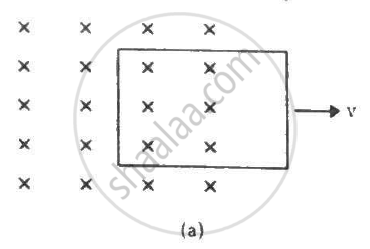

A conducting loop is placed in a uniform magnetic field with its plane perpendicular to the field. An emf is induced in the loop if ___________.
A rod AB moves with a uniform velocity v in a uniform magnetic field as shown in figure.
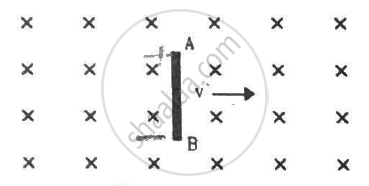
A conducting circular loop having a radius of 5.0 cm, is placed perpendicular to a magnetic field of 0.50 T. It is removed from the field in 0.50 s. Find the average emf produced in the loop during this time.
A conducting circular loop of area 1 mm2 is placed coplanarly with a long, straight wire at a distance of 20 cm from it. The straight wire carries an electric current which changes from 10 A to zero in 0.1 s. Find the average emf induced in the loop in 0.1 s.
Figure shows a square loop of side 5 cm being moved towards right at a constant speed of 1 cm/s. The front edge enters the 20 cm wide magnetic field at t = 0. Find the emf induced in the loop at (a) t = 2 s, (b) t = 10 s, (c) t = 22 s and (d) t = 30 s.

Figure shows a circular coil of N turns and radius a, connected to a battery of emf εthrough a rheostat. The rheostat has a total length L and resistance R. the resistance of the coil is r. A small circular loop of radius a' and resistance r' is placed coaxially with the coil. The centre of the loop is at a distance x from the centre of the coil. In the beginning, the sliding contact of the rheostat is at the left end and then onwards it is moved towards right at a constant speed v. Find the emf induced in the small circular loop at the instant (a) the contact begins to slide and (b) it has slid through half the length of the rheostat.
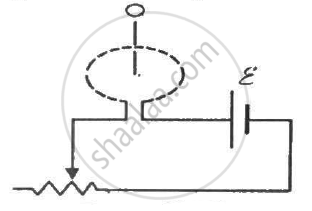
Consider the situation shown in figure. The wires P1Q1 and P2Q2 are made to slide on the rails with the same speed 5 cm s−1. Find the electric current in the 19 Ω resistor if (a) both the wires move towards right and (b) if P1Q1 moves towards left but P2Q2 moves towards right.
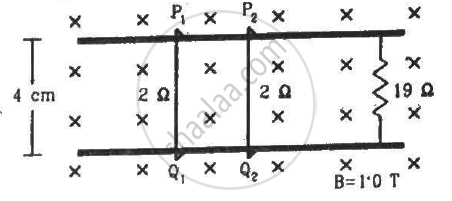
A bicycle is resting on its stand in the east-west direction and the rear wheel is rotated at an angular speed of 100 revolutions per minute. If the length of each spoke is 30.0 cm and the horizontal component of the earth's magnetic field is 2.0 × 10−5 T, find the emf induced between the axis and the outer end of a spoke. Neglect centripetal force acting on the free electrons of the spoke.
A current carrying infinitely long wire is kept along the diameter of a circular wire loop, without touching it, the correct statement(s) is(are)
- The emf induced in the loop is zero if the current is constant.
- The emf induced in the loop is finite if the current is constant.
- The emf induced in the loop is zero if the current decreases at a steady rate.
Two identical coaxial coils P and Q carrying equal amount of current in the same direction are brought nearer. The current in ______.
In the given figure current from A to B in the straight wire is decreasing. The direction of induced current in the loop is A ______.
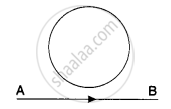
The current flowing in a step-down transformer 220 V to 22 V having impedance 220 π is
